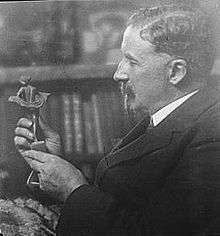Paris Singer
Paris Eugene Singer (20 February 1867 – 24 June 1932) was an early resident of Palm Beach, Florida. He was 22nd[1] of the 24 children of inventor and industrialist Isaac Singer of Singer Sewing Machine Company fame, from whom he inherited money; he has been described as a "man of luxury".[2]:18 Born in Paris, he married Cecilia Henrietta Augusta ("Lillie") Graham (b. Perth Australia, 6 June 1867; d. Paignton, 7 March 1951), who bore him five children.[3]:153 He had a tempestuous romance with famous dancer Isadora Duncan, whose career he helped, and with whom he had another son, Patrick (born 1910, drowned 1913). Singer Island, Florida, is named for him.
Paris Eugene Singer | |
|---|---|
 Paris Singer, 1916 | |
| Born | February 20, 1867 Paris, France |
| Died | June 24, 1932 (aged 65) London, England |
| Resting place | Torquay, England |
| Nationality | American |
| Occupation | Real estate developer, philanthropist |
| Known for | Friendship with architect Addison Mizner; building the Everglades Club |
| Net worth | Multi-millionaire |
| Spouse(s) | Cecilia Henrietta Augusta ("Lillie") Graham |
| Children | 5 by Lillie, and 1 by Isadora Duncan |
| Parent(s) | Isaac Singer |
In 1917 Singer met the future Palm Beach architect Addison Mizner; they became "inseparable."[3]:157 It was through Singer's influence that Mizner arrived in Palm Beach on January 5, 1918, in part for his health; he was Singer's house guest (at 123 Peruvian Avenue).[4]:xix–xx[3]:155 Mizner's first Florida project was transforming Singer's unimpressive "villa" into the Chinese Villa, in which Singer lived until the Everglades Club was completed in 1919.[3]:156
Mizner said of Singer in 1917:
[He was] the cause of my existence for the next ten tears. He was the finest-looking man I ever saw; six feet, three or four, straight as a die, with a fine figure. At this time, he was fifty and looked forty.
He wrote later:
Paris was a strange, silent man, who loved to look on but hard to talk to unless you got him on his own subjects. At this time it was hospital work.[4]:xix
Singer had built a string of hospitals in England and France "for the war-wounded" (in the First World War). At the urging of Lady Randolph Churchill, he donated the use of his house at Oldway in Paignton to be used by the American Women's War Relief Fund as a military hospital.[5][6] Deciding to build one in Palm Beach, after consulting with Mizner, he bought a large parcel of land on which the "Touchstone Convalescent Club"[7]: was to be built. He hired Mizner to build it, and Mizner moved to Palm Beach.[3]:158 Mizner purchased from him the "virtually inoperable pottery factory, 'Las Manos' ['The Hands']".[8]
Paris Singer was the president of the Everglades Club, as the convalescent home soon became (the war had ended), and lived there in an apartment constructed for him.[3]:160 He planned on what became Singer Island a hotel, the Blue Heron, designed by Mizner, to be the most luxurious ever built, as part of a large new resort.[3]:215 An "aerial ferry" would connect it to the mainland, with 12 cable cars 136 feet above the water,[2]:45 since West Palm Beach refused to permit a bridge.[7]:167 It was the largest building Mizner ever designed.[7]:167 Because of the Florida real estate collapse of 1926 and its effects on Singer, the hotel was not completed. It was known as "Singer's Folly" until razed in 1940.[7]:167
The real estate collapse also contributed to the end of Singer's close friendship with Mizner, which ended in 1927.[3]:232 The Everglades Club went into receivership, as Singer was unable to service the loans for which the club was collateral. He was arrested in April, 1928, at the Everglades Club, on charges of real estate fraud.[3]:232–233 A judge dismissed the charges three weeks later,[7]:168 but Singer, having been publicly humiliated, left Palm Beach immediately and never lived there again.[3]:233
The stock market crash of 1929 further depleted his funds, and he spent his final years quietly with his wife and former nurse Joan Balsh in his Moorish house (since demolished) in Saint-Jean-Cap-Ferrat, France.[3]:234–235 He died in London.
References
- "The 24 Children of Isaac Singer". Nancy's Baby Names. 2017-11-13. Retrieved 2018-08-08.
- Orr, Christina (1977), Addison Mizner: Architect of Dreams and Realities, Norton Gallery of Art
- Seebohm, Caroline (2001), Boca Rococo. How Addison Mizner Invented Florida's Gold Coast, Clarkson Potter, ISBN 0609605151
- Silvin, Richard René (2014). Villa Mizner: The House that Changed Palm Beach. Star Group Books. ISBN 9781884886744.
- "The American Women's War Hospital at Oldway, Paignton 1914 to 1918". The American Women's War Hospital. Archived from the original on 18 January 2018. Retrieved 2018-04-26.
- Sebba, Anne (2007). American Jennie: The Remarkable Life of Lady Randolph Churchill. New York: W. W. Norton & Company. p. 307. ISBN 9780393079685.
- Curl, Donald W. (1992), Mizner's Florida, The Architectural History Foundation and the MIT Press, p. 7, ISBN 0262530686,
First published 1984
- Waugh, Alex; Doyle, Robert V. (1978), "Alex in Miznerland", in J. Camille Showalter (ed.), The Many Mizners: California Clan Extraordinary, Oakland Museum, pp. 55–62, at p. 59